Master the fragrance wheel by first learning the four main scent families: Floral, Oriental, Woody, and Fresh. Train your nose to identify top, middle, and base notes through consistent scent testing. Explore complementary fragrances by pairing opposite scents on the wheel, or create harmony with adjacent notes. Build your personal scent library starting with cornerstone fragrances, and experiment with custom blending techniques. These foundational steps will open up your journey into professional-level perfumery.
Understanding The Basic Structure Of Scent Families
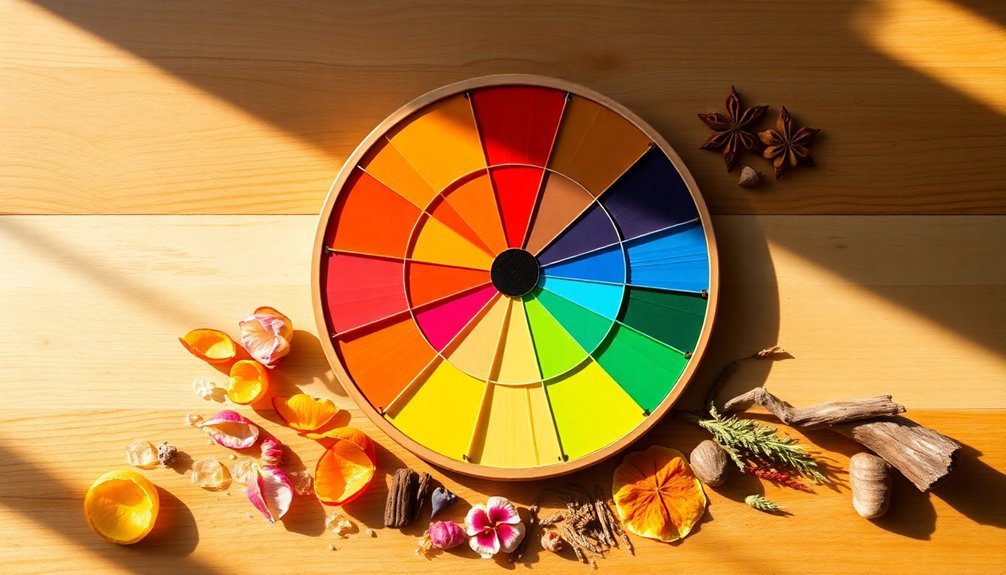
While exploring the world of fragrances might seem overwhelming at first, understanding the four main scent families provides a clear starting point.
The fragrance wheel organizes scents into Floral, Oriental, Woody, and Fresh families, each with distinct aromatic characteristics.
You'll find that Floral scents feature delicate notes like jasmine and rose, while Oriental fragrances embrace rich vanilla and spices.
Woody scents offer warm, earthy elements through sandalwood and cedar notes, often complemented by floral undertones.
Fresh fragrances deliver invigorating citrus, herbal, and aquatic profiles perfect for casual wear.
Each scent family breaks down into subfamilies that help you pinpoint specific characteristics.
For example, you'll discover Soft Floral and Gourmand subcategories that let you navigate the fragrance wheel with greater precision and confidence.
Learning To Identify Individual Notes And Accords
Now that you understand the basic scent families, developing your ability to identify individual notes and accords will sharpen your fragrance expertise. Focus first on distinguishing between top notes, middle notes, and base notes through regular scent testing sessions. Understanding how notes combine to create accords is essential for mastering scent placement on the fragrance wheel.
| Note Type | Common Examples |
|---|---|
| Top Notes | Citrus, Herbs |
| Middle Notes | Floral fragrances, Spices |
| Base Notes | Woody notes, Musk |
| Accords | Oriental, Chypre |
Train your nose by breaking down complex fragrances into their individual components. Start with simple scents and gradually work your way up to more complex combinations. Keep a fragrance journal to track your observations and document how different notes evolve over time.
Exploring Complementary And Contrasting Fragrances
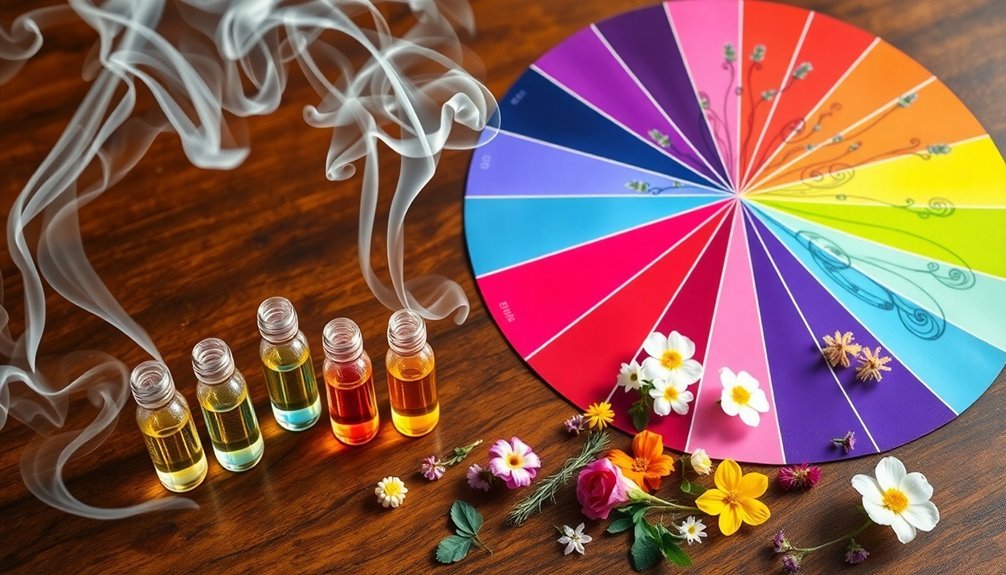
Understanding how fragrances interact with each other opens up exciting possibilities for creating unique scent combinations.
When you're exploring the fragrance wheel, you'll discover two main approaches to fragrance selection: complementary fragrances and kindred notes.
Complementary fragrances sit opposite each other on the wheel, like pairing an Amber fragrance with a Fresh scent. These contrasting fragrances create intriguing combinations that balance warmth with brightness.
Meanwhile, kindred notes, found in adjacent scent families, offer harmonious blends that maintain consistency while adding depth.
You can also try the triangle technique by selecting three subfamilies that form a triangle on the wheel.
This method guarantees a well-rounded fragrance experience with balanced top, middle, and base notes, giving you more control over your scent story.
Developing Your Personal Scent Library
Building a personal scent library begins with exploring the four cornerstone fragrance families: Floral, Oriental, Woody, and Fresh.
Using the fragrance wheel as your guide, you'll discover how each fragrance subfamily connects and interacts, from delicate floral notes to rich notes of amber in woody oriental blends.
Start by documenting each aromatic fragrance's evolution, noting how top, middle, and base notes develop throughout the day. You'll find that fresh fragrances might shift differently than deeper, oriental scents.
As you expand your collection, experiment with combining scents from different families—perhaps layering a light floral with a warm woody oriental.
Keep detailed records of your discoveries, regularly adding new fragrances and revisiting familiar ones to track how your preferences evolve and your understanding of scent combinations deepens.
Applying The Wheel For Custom Fragrance Blending
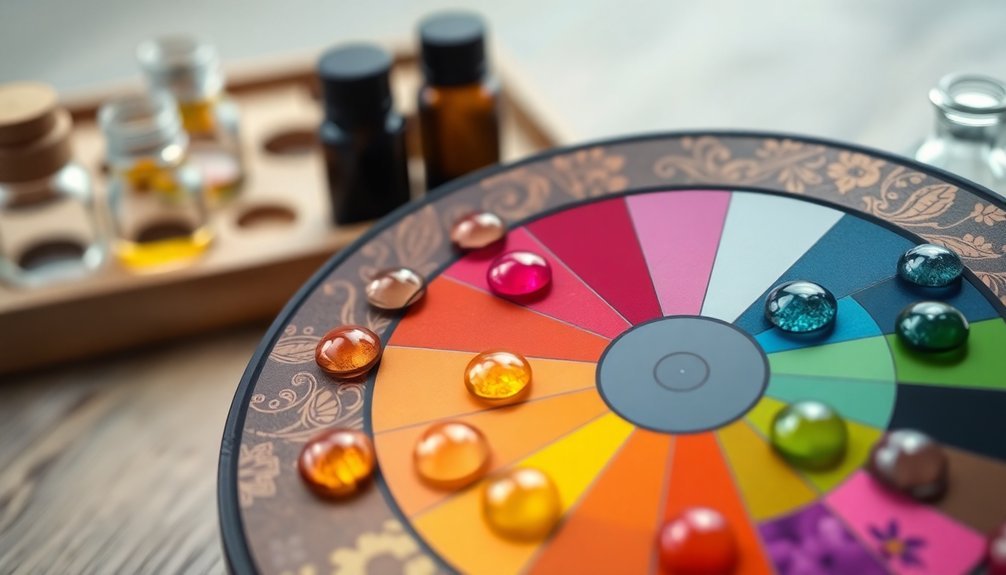
Creating custom fragrance blends transforms from guesswork into artistry when you leverage the fragrance wheel's intuitive structure. You'll discover how adjacent families offer complementary notes that enhance your primary scent, while the triangle technique lets you select three subfamilies for perfect balance.
| Technique | Method | Result |
|---|---|---|
| Adjacent | Blend neighboring scents | Harmonious depth |
| Triangle | Connect three subfamilies | Balanced layers |
| Opposite | Pair contrasting notes | Unexpected intrigue |
To build your custom fragrance, start with a dominant note, then explore the wheel's neighboring sections. You can create depth by combining floral with woody scents, or experiment with opposite families for striking contrasts. Remember to contemplate how top, middle, and base notes will evolve together as you craft your signature blend.
Frequently Asked Questions
What Is the 30 50 20 Rule for Perfume?
You'll want to blend your perfume using 30% top notes for initial scent, 50% middle notes for the main character, and 20% base notes for lasting depth – it's a proven formula for balance.
What Is the Fragrance Wheel Theory?
You'll find that the Fragrance Wheel Theory, created by Michael Edwards, organizes scents into four main families: Floral, Amber, Woody, and Fresh, helping you understand how different fragrances relate and complement each other.
What Are the 4 Categories of Fragrance?
You'll find four main fragrance families that define perfumery: Floral (featuring flower-based scents), Oriental (with warm, spicy notes), Woody (containing earthy elements), and Fresh (offering light, citrusy and herbal aromas).
Does Putting Vaseline Before Perfume Work?
Yes, applying Vaseline before perfume does work. You'll notice your fragrance lasts longer because Vaseline creates a barrier that prevents quick evaporation. It's especially effective when you apply it to your pulse points.
In Summary
You've now got the tools to navigate the fragrance wheel like a pro. With your knowledge of scent families, individual notes, and complementary combinations, you're ready to curate your own signature fragrances. Don't be afraid to experiment with contrasting scents and build your personal library. Whether you're blending custom perfumes or choosing daily scents, the fragrance wheel will be your trusted guide.
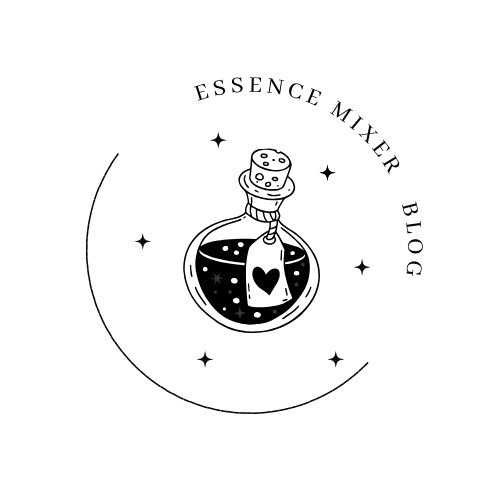
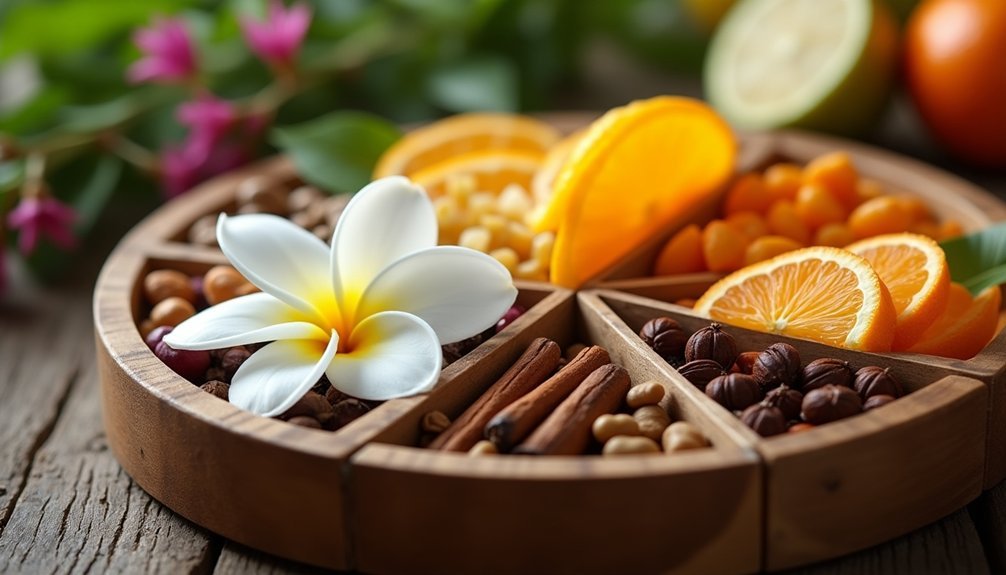



Leave a Reply